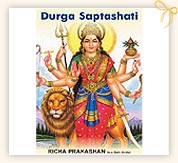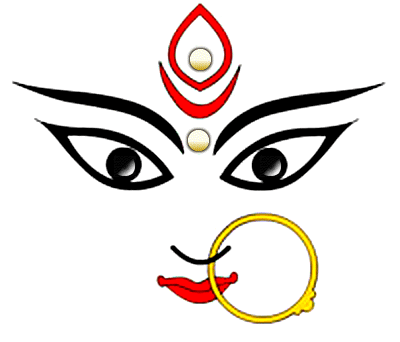 |
|
\
Hindu Of Universe |
 |
HinduOFUniverse
Space Available for
Advertisements
Contact: +92-03333130724
Space Available for
Advertisements
Contact: +92-03333130724
Space Available for
Advertisements
Contact: +92-03333130724 |
|
|
|
 |
|
HinduOfUniverse
Durga Saptashati
 Durga Saptashati
Durga Saptashati, means 700 slokas
(verses) to Devi Durga, is a part of the Markandeya Purana.
The Markadeya Purana is one among the 18 Puranas.
The Saptashati is also known as Chandi Path or Devi
Mahatmya. The most common and widely recognized is Devimahatmya
[The Glory of the Goddess]. The other is Shri Durga Saptashati (Seven
Hundred Verses to Sri Durga). It is divided into 3 parts, dedicated to
the Goddess - Kali, Lakshmi and Saraswati.
It is widely considered auspicious to recite the different chapters of
the Saptashati on the nine days of Navratri. The Durga
Saptashati is a sacred text used by Hindus for daily chanting to the
Divine Mother throughout India.
The original text has been printed in Devanagri type with English
translation, and added footnotes. Three aspects of the Divine Mother
are depicted in the book :
- Mahakali
- Mahalakshmi
- Mahasaraswati
Durga Puja

Origin of Durga - The Mythology
Devi is the great goddess of the Hindus,the
consort of Shiva and she is worshiped in various forms corresponding to her two
aspects: benevolence and fierceness. She is Uma, "light"; Gauri, "yellow or
brilliant"; Parvati, "the mountaineer" ; and Jagatmata, "the-mother-
of-the-world" in her milder guise. The terrible emanations are Durga "the
inaccessible" ; Kali, "the black"; Chandi, "the fierce"; and Bhairavi, "the
terrible."
Descent of the Goddess
Durga, a beautiful warrior
seated upon a tiger, was the first appearance of the great goddess. The
circumstance of her miraculous arrival was the tyranny of the monster-demon
Mahishasur, who through terrific austerities had acquired invincible strength.
The gods were afraid of this water-buffalo bull because neither Vishnu nor Shiva
could prevail against him. It seemed that the joint energy of Shakti was only
capable of vanquishing Mahisha, and so it was the eighteen-armed Durga who went
out to do battle.
Battlefield
She went to battle on her
ferocious mount lion, armed with the weapons given to her by the other Gods.
Durga is one of the angry and aggressive aspects of the goddess Shakti, whose
role in Hindu mythology was to fight and conquer demons and also personify the
Sakti or female aspect of any male deity. In the battle, she fought and killed
the evil Mahishasura and restored heaven to the Gods. Since then the goddess is
invoked for protection from the powers of evil. Durga Puja is observed in her
honor, to celebrate her victory over evil.
Revered Mother
She
has been worshiped from about 400 AD, but probably earlier, to the present. Her
literary references are chiefly the Ramayana and Mahabharata, epic and Puranic
texts, and she is mentioned by name in Vedic literature. In general, Durga is
regarded in northern India as the gentle bride epitomizing family unity while in
southern India she is revered more in her warrior aspect.
Dussehra
The festival of Dassehra, also known as
Vijayadashmi, is one of the fascinating festivals of India and is celebrated
with joy and enthusiasm. According to the great Hindu scripture, the Ramayana,
Lord Rama performed chandi-puja (holy prayer). This was carried out in order to
invoke the blessings of Durga Maa for the killing of Ravana, the ten-headed
demon king of Sri Lanka who had abducted Seeta, wife of Lord Rama.
Durga
Maa divulged the secret to Rama on how he could slay the great Ravana. Hence
upon vanquishing the demon Ravana, Lord Rama with Sita and younger brother
Laxmana, returned victorious to his kingdom of Ayodhya on the day which is
called 'Diwali'. Revelers across northern India re-enact the legend at sundown
in a performance called the Ramlila, featuring actors dressed as Rama shooting
flaming arrows at effigies stuffed with firecrackers.
Dassera day is
considered a most auspicious day. It is a time-honored belief that if any new
venture is started on this day, it is bound to be successful. Hence, all the
undertakings be it laying-in of foundation of a new building, opening of a new
commercial establishment or even initiating a child into the world of learning-
are started on this day. Also on this day implements of agriculture,
manufacturer' s machines, the intellectuals pens, the household articles, the
children's school books are placed before the idol of Durga and worshiped.
The Bengali
Belief
Sati, the consort of Shiva was the daughter of Daksha
Prajaapati a descendant of Bhrama. Sati had married Shiva against the wishes of
her father. Daksha was sponsoring a sacrifice and attendees came from various
parts of the universe. He invited all of the gods and goddesses except his son
in law Shiva. Against Shiva's wishes, Sati attended this sacrifice and was
insulted by her father. Unable to bear this insult, Sati immolated herself.
Enraged at the insult and the injury, Shiva destroyed Daksha's
sacrifice, cut off Daksha's head and when pleaded by other gods, replaced it
with that of a goat and restored him to life. Still berserk with grief, he
picked up the remains of Sati's body, and danced the dance of destruction
throughout the Universe. The other gods intervened to stop this dance, and the
disk of Vishnu cut through the corpse of Sati, whose various parts of the body
fell at several spots all through the Indian subcontinent and formed the sites
of what are known as Shakti Peethas today.
Shiva was finally pacified
when the last piece fell off from his shoulder. Narayana revived sati as Uma for
a new life. Ever since peace was restored, Uma, with her children, Ganesh and
Kartick, and with her two 'sakhis' - Jaya and Bijaya, comes to visit her
parent's home each year during the season of 'Sharat' or autumn when Durga Puja
is celebrated.
Mahalaya
Mahalaya ushers in the aura of Durga Puja. The countdown for the
Durga Puja begins much earlier, from the day of 'Janmastami' . It is only from
the day of Mahalaya that the preparations for the Durga Puja reaches the final
stage. The midnight chants of various hymns of 'Mahishasura Mardini' reminds one
of the beginning of Durga Puja.
Mahalaya is an auspicious occasion
observed seven days before the Durga Puja, and heralds the advent of Durga, the
goddess of supreme power. It's a kind of invocation or invitation to the mother
goddess to descend on earth - "Jago Tumi Jago". This is done through the
chanting of mantras and singing devotional songs.
The day of Mahalaya is
also the day of remembrance. On this day, people offer 'tarpan' in memory of
their deceased forefathers. The banks of River Ganga becomes a sea of humanity.
Priests are seen busy performing 'Tarpan' for devotees in groups. The rituals
start from early down and end during the midday. Devotees and worshipers buy
clothes and sweets to offer to their forefathers. 'Tarpan' is to be performed in
empty stomach. After offering 'tarpan', people eat at the same place.
|
|
 Durga Saptashati, means 700 slokas
(verses) to Devi Durga, is a part of the Markandeya Purana.
The Markadeya Purana is one among the 18 Puranas.
Durga Saptashati, means 700 slokas
(verses) to Devi Durga, is a part of the Markandeya Purana.
The Markadeya Purana is one among the 18 Puranas.
